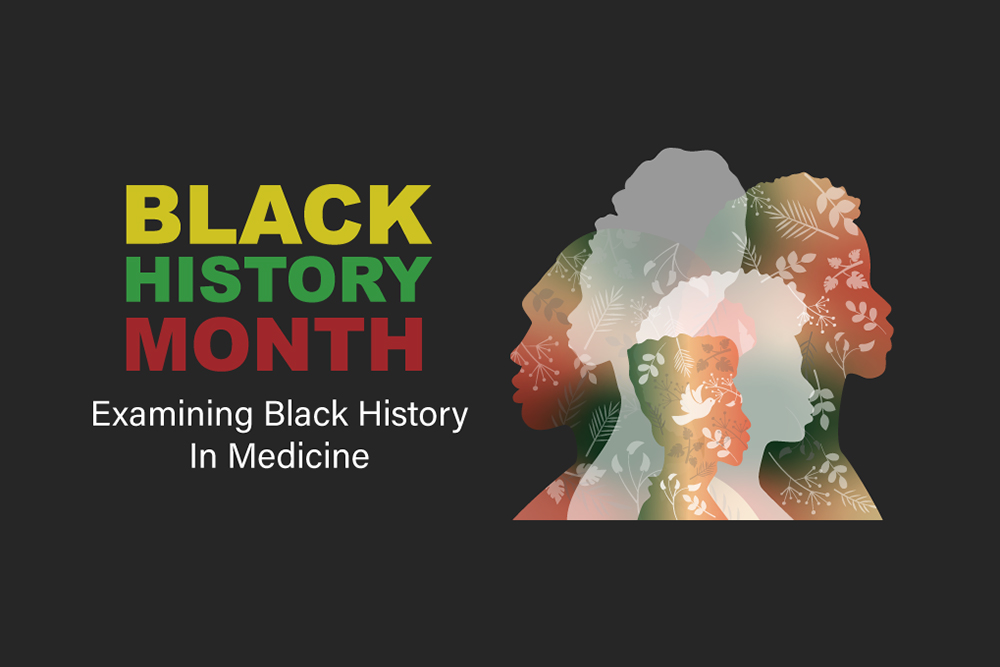
February is Black History Month, a time to honor the many generations of Black Americans who have overcome hardship and made significant contributions to society. This year, MCR Health wants to draw attention to the influence black medical professionals have had on the field, particularly those who broke down barriers and paved the way for future advancements that benefit all Americans.
Pacemakers, blood transfusions, neurosurgery on conjoined twins, and open heart surgery are just a few of the areas where Black medical experts have advanced healthcare and saved millions of lives.
The healthcare contributions made by Black physicians, researchers, and other medical professionals are vast. Even though America’s healthcare has been tainted by racial injustices like unequal access, segregation, and deeply unethical testing in the past, we owe a huge debt of gratitude to these innovators who have helped advance medical knowledge and save many lives.
However, despite playing a crucial role in medicine, there are not enough Black doctors in the country compared to the size of the population. Even though African Americans or people who identify as black make up more than 13% of the US population, they account for only about 5% of medical professionals. While there is still much work to be done in terms of representation in medicine, we benefit greatly from the knowledge, dedication, and commitment of Black medical experts, both past and present.
In honor of Black History Month, MCR has compiled a list of notable figures who have advocated for better health care access for Black Americans, helped develop medical breakthroughs, and broken glass ceilings for women in the medical field.
Rebecca Lee Crumpler, M.D.
Dr. Rebecca Lee Crumpler was a nurse for nearly ten years before becoming the first African American woman in the United States to earn a medical degree. Crumpler practiced as a nurse and doctor in Massachusetts and Virginia.
Crumpler, who graduated from medical school in 1864, focused her practice on women and children. In 1883, she published what is thought to be the first medical text written by an African American author. The book discussed disease treatment and prevention in women and children.
James Durham
There are very few historical records on James Durham. But Durham is widely thought to be the first African American doctor in the United States.
Durham was born into slavery in 1762 and worked as an assistant to doctors who purchased him. He never earned a degree in medicine, but he is said to have bought his freedom and set up a medical practice in New Orleans. When yellow fever broke out in New Orleans in the late 1780s, he played an important role in treating patients.
James McCune Smith
Dr. James McCune Smith was not just any physician. He was the first African American to earn a medical degree. In the 1830s, he went to school at the University of Glasgow because no American university would enroll him. For this groundbreaking achievement alone, Smith warrants greater appreciation.
Smith was also one of the nation’s leading abolitionists. In 1859, Frederick Douglass declared, “No man in this country more thoroughly understands the whole struggle between freedom and slavery than does Dr. Smith, and his heart is as broad as his understanding.” Smith was a very prolific writer. He was the first African American to publish peer-reviewed articles in medical journals. He also wrote essays and gave lectures that debunked false scientific claims that black people were inferior and predicted how African Americans would change the culture of the world.
Smith was one of the first people to join the Glasgow Emancipation Society. This was in 1833, just before slavery was outlawed in Britain. He earned his bachelor’s, master’s, and medical degrees in just five years, graduating near the top of his class. He then completed his residency in Paris.
In 1837, Smith opened the first black-owned pharmacy in the United States at 55 West Broadway, where he also had his medical office. He saw both black and white patients, men and women.
Myra Adele Logan
Dr. Myra Adele Logan became the first woman to perform open heart surgery in 1943, the ninth operation of its kind performed anywhere in the world. She was also one of the first African American women to be elected as a fellow of the American College of Surgeons. Dr. Logan’s other accomplishments include the development of antibiotics such as aureomycin, work on early detection and treatment of breast cancer, and efforts to develop x-ray processes that detect differences in tissue density more accurately, allowing tumors to be detected earlier.
Dr. Logan was a founding partner and treasurer of the Health Insurance Plan’s (HIP) Upper Manhattan Medical Group, one of the first group practices in the United States. She also worked with the NAACP’s Health Committee, the New York State Fair Employment Practices Committee, the National Cancer Committee, and Planned Parenthood. During the administration of then-New York Governor Thomas E. Dewey, she served on the New York State Commission on Discrimination.
Patricia Bath, M.D.
Dr. Patricia Bath became the first black person to complete a residency in ophthalmology and a founding member of the American Institute for the Prevention of Blindness. Dr. Bath was also the first Black female physician to receive a medical invention patent.
Dr. Bath was also instrumental in bringing ophthalmic surgical services to Harlem Hospital’s Eye Clinic, which at the time did not perform eye surgery. She persuaded her Columbia professors to operate on blind patients for free, and she volunteered as an assistant surgeon. As a result of her efforts, the first major eye operation at Harlem Hospital was performed in 1970.
Dr. Bath joined the faculties of UCLA and Charles R. Drew University in 1974 as an assistant professor of surgery (Drew) and ophthalmology (UCLA). The following year, she became the first woman faculty member in the Department of Ophthalmology at UCLA’s Jules Stein Eye Institute. When she became the first woman faculty member in the department, she was offered an office “in the basement next to the lab animals.” She refused the spot. “I didn’t say it was racist or sexist. I said it was inappropriate and succeeded in getting acceptable office space. I decided I was just going to do my work.” By 1983, she was chair of the ophthalmology residency training program at Drew-UCLA, the first woman in the US to hold such a position.
Even though both UCLA and Drew have policies that promote equality and condemn discrimination, Professor Bath experienced both sexism and racism during her time at both schools. Not wanting the “glass ceilings” in the US to get in the way of her scientific work, Dr. Bath took her research to Europe. Her work was accepted because of its exceptional quality at the Laser Medical Center in Berlin, West Germany; the Rothschild Eye Institute in Paris, France; and the Loughborough Institute of Technology in England. Her laser surgery patents serve as proof that she performed at her “personal best” while working at those institutions in terms of research and laser science.
Bath’s work and interests, however, always went beyond the confines of a university. In 1977, she and three other colleagues founded the American Institute for the Prevention of Blindness, an organization whose mission is to protect, preserve, and restore the gift of sight. The AIPB is based on the principle that eyesight is a basic human right and that primary eye care must be made available to all people, everywhere, regardless of their economic status. Much of the work of the AIPB is done by ophthalmic assistants, who are trained in programs at major universities. The institute helps fund global efforts to give newborn babies eye drops that protect them from infections, to make sure that malnourished children get vitamin A supplements that are important for their eyesight, and to vaccinate children against diseases like measles that can cause blindness.
Dr. Bath was also a laser scientist and inventor. Her interest, experience, and research on cataracts led to the development of the laserphaco probe, a new device and method for removing cataracts. When she first thought of the device in 1981, it was ahead of its time in terms of technology. It took her nearly five years to complete the research and testing needed to make it work and apply for a patent. Today, the device is used worldwide. With the keratoprosthesis device, Dr. Bath was able to restore the sight of several individuals who had been blind for over 30 years.
Charles R. Drew, M.D.
Dr. Charles Richard Drew was an African American surgeon who pioneered methods of storing blood plasma for transfusion and organized the first large-scale blood bank in the United States.
Dr. Drew attended McGill University’s Faculty of Medicine in Montreal to pursue his medical career. He graduated second in his class in 1933, completed his internship there, and became a pathology instructor at Howard University School of Medicine in Washington, D.C., in 1935. Two years later, he became assistant professor of surgery and chief surgical resident at Freedmen’s Hospital, Howard University’s teaching hospital.
Dr. Drew’s work separating plasma from blood at Howard University made it possible to store blood for a week. Before this, blood could only be stored for a few days. He found that plasma alone could be used for transfusions, expanding the number of patients he could treat.
In 1938, Dr. Drew was given a Rockefeller Fellowship to study blood storage and distribution at the Presbyterian Hospital in the City of New York, which is now called the New York-Presbyterian/Columbia University Irving Medical Center. He was also named a resident in surgery and admitted to the Doctor of Medical Science program at Columbia University, one of the first African-American students to do this.
While working in the Department of Surgery with Dr. John Scudder, one of the first blood transfusion specialists in the country, Dr. Drew started and ran an early prototype program for storing and preserving blood. He had developed a technique for long-term plasma storage by the time he received his doctorate in 1940, earning him the nickname “Father of the Blood Bank.”
His research was quickly put to use when Great Britain requested 5,000 vials of dried plasma for transfusions, plus more three weeks later, for use in military hospitals during World War II. To meet the need, Dr. Drew organized blood drives at New York City hospitals. The program, called “Blood for Britain,” lasted five months, with 15,000 American blood donors participating.
As the U.S. prepared to enter the war, the American Red Cross asked Dr. Drew to be the first director of its blood bank. Dr. Drew accepted and started the Red Cross Blood Bank in February 1941, with 35 centers across the U.S. storing blood for injured servicemen. His Red Cross work was brief. When the Red Cross announced it would segregate white and black donor blood later that year, Dr. Drew took a moral stand. He protested the decision on moral and scientific grounds and resigned.
Dr. Drew returned to Howard University as the chair of surgery with the goal of training the next generation of African-American medical students. But his achievements did not stop there. He was the first black surgeon to become an American Board of Surgery examiner in 1942, and two years later, the National Association for the Advancement of Colored People awarded him the Spingarn Medal for his humanitarian work. After being elected to the International College of Surgeons in 1946, Dr. Drew began a campaign to get the American Medical Association to admit black doctors.
Daniel Hale Williams, M.D.
Dr. Daniel Hale Williams pioneered many medical advances. Dr. Hale was one of the first surgeons to successfully perform open heart surgery, paving the way for many others. Dr. Williams also founded the first interracial hospital, Provident Hospital and Training School, two hospital-based nursing programs, the National Medical Association, and was the first African American physician admitted to the American College of Surgeons. Dr. Williams’ advocacy for African Americans in medicine is honored by educational institutions worldwide.
During the late 1800s and early 1900s, Dr. Williams was the most famous African-American surgeon in the United States. Even though he is best known for his surgical work (he was the second person to fix a stab wound to the pericardium in 1893, and he was one of the first people to fix a piercing wound to the spleen in 1902), his most important contribution was fighting for African Americans to have the same access to medical care and training as white people.
Dr. Williams had a major impact on the major health institutions of Black America. After he graduated from Chicago Medical College in 1883, hospitals in Chicago refused to hire him because of his race. In 1891, he founded Provident Hospital, the country’s first black hospital for inpatient care, as well as a training facility for black nurses and doctors. He was the chief of surgery at Freedmen’s Hospital in Washington, DC, from 1894 to 1898. During that time, he reformed the nursing school and started a training program for surgeons. He was a driving force behind the formation of the National Medical Association in 1895, and he served as its first vice president.
The success of his annual clinics at Meharry Medical College, which began in 1900, motivated the black community in Nashville, TN, to open an inpatient facility, the forerunner of a wave of black hospitals across the U.S. In 1913, he became a charter member of the American College of Surgeons and its first black fellow.
Jocelyn Elders, M.D.
Dr. Jocelyn Elders, who was a physical therapist in the 1950s, helped then-President Dwight Eisenhower recuperate from a heart attack. In 1993, Dr. Elders became the first Black person to serve as surgeon general of the United States. During her time as surgeon general, she pushed for schools to teach about drugs and give out birth control.
Minnie Joycelyn Jones was born in 1933 to sharecropper parents in Schaal, Arkansas. She and her seven younger siblings often worked in the cotton fields. It was in those cotton fields that she and her siblings earned enough money to pay for her education. Joycelyn Jones enrolled at Philander Smith College, a historically Black college in Little Rock, Arkansas, when she was 15 years old, thanks to a United Methodist Church scholarship. After graduating in only three years, she joined the United States Army and trained in physical therapy in Houston, Texas. She used the GI Bill to attend the University of Arkansas Medical School in 1956. She was the only woman to graduate from the school four years later, earning her medical degree.
Dr. Joycelyn Elders graduated from the University of Arkansas with a master’s degree in biochemistry in 1967. She joined the faculty of the University of Arkansas School of Medicine as a pediatric endocrinologist clinician and researcher.
Dr. Joycelyn Elders was appointed as the 15th Surgeon General of the United States in 1993, becoming the first African American and the second woman to hold the position. She was chosen by President Bill Clinton, who had also put Dr. Elders in charge of the Arkansas Department of Health from 1987 to 1992 when he was Governor. After 15 months as Surgeon General, Dr. Elders returned to the University of Arkansas as a faculty researcher and professor of pediatric endocrinology at Arkansas Children’s Hospital.
Louis T. Wright, M.D.
Dr. Louis Tompkins Wright was a graduate of Clark University Atlanta and then Harvard Medical School, graduating fourth in his class in 1915. Aside from being a renowned American surgeon, he was also a WWI veteran, community leader, and activist.
Prior to entering the war, Dr. Wright, along with his stepfather and others, founded Atlanta’s NAACP chapter. Dr. Wright would go on to become the first African American chairman of the NAACP Board of Directors.
In 1919, Wright moved to New York City and became the first African American physician on the staff at Harlem Hospital. The white medical superintendent who hired him was harshly criticized and placed in a lower position, and a few white staff members quit in protest of his hiring. This did not deter Wright, who continued to advance and, in 1943, became the Director of Surgery at the institution and a well-respected medical leader in New York.
He pioneered intradermal (within the skin) vaccination for smallpox while serving in the Army Medical Corps during World War I. In 1948, he was hailed as the first clinician to investigate the treatment of humans with aureomycin.
Celebrate Black History with MCR
Some of the most impressive and notable advancements in medicine have been made by Black physicians, scientists, inventors, and researchers. While our list barely scratches the surface, all of these contributions have made and continue to make healthcare what it is today.
MCR recognizes and honors Black medical pioneers, who all contribute significantly to the care of our community and our country, throughout Black History Month and every month.

